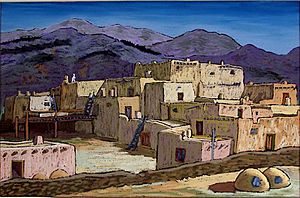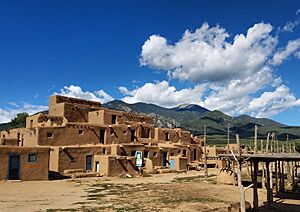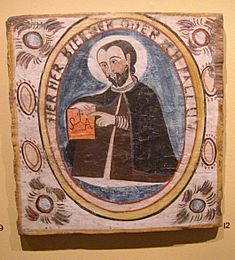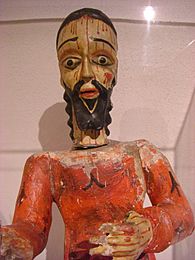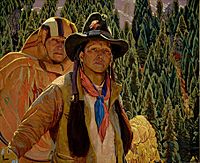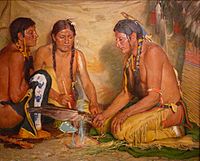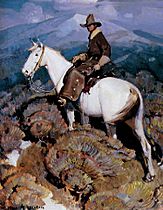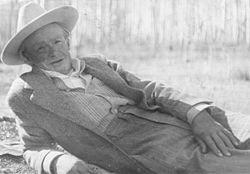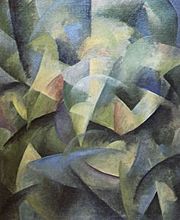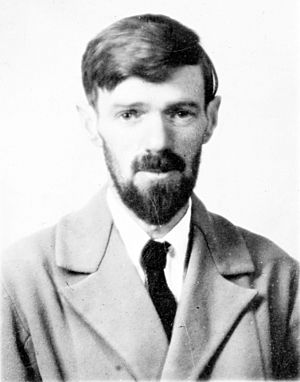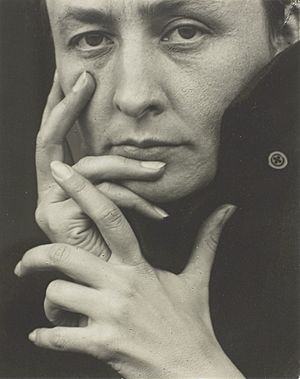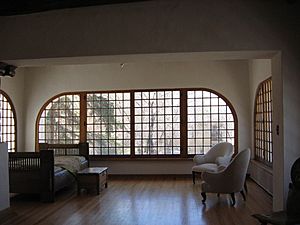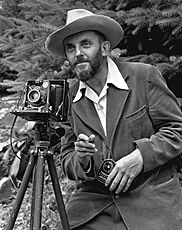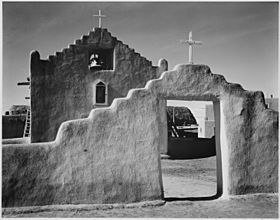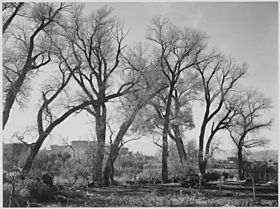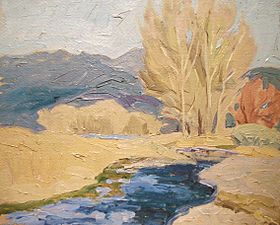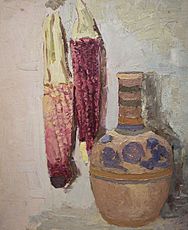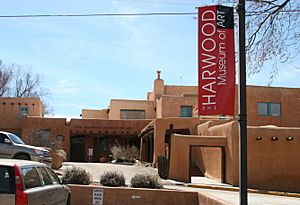Taos art colony facts for kids
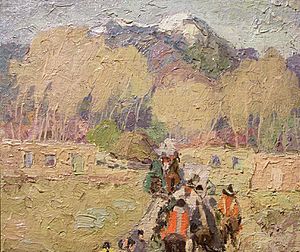

The Taos art colony is a famous group of artists who came together in Taos, New Mexico. They were drawn to the unique culture of the Taos Pueblo and the beautiful landscapes of northern New Mexico. Local traditions, like Hispanic furniture making and tin work, also helped create a rich mix of art in the area.
The art colony really began in 1898 when artists Bert Geer Phillips and Ernest L. Blumenschein visited Taos. This led to the creation of the Taos Society of Artists. Another important person was Mabel Dodge Luhan, who invited many famous artists and writers to Taos.
In the early 1900s, modern artists brought new energy to the area. Later, in the 1950s, abstract artists joined them. Today, Taos is still a lively art hub with over 80 galleries and three museums. Many groups support and promote the amazing art created by people from the Taos Pueblo and the surrounding area.
Contents
- History of Taos Art
- The Taos Art Colony: A Creative Hub
- Taos Society of Artists: Painting the Southwest
- Mabel Dodge Luhan: Bringing Creativity to Taos
- Andrew Dasburg: A Cubist in New Mexico
- D.H. Lawrence: Writing and Painting in Taos
- Georgia O'Keeffe: Iconic Southwest Art
- Nicolai Fechin: A Russian Artist in Adobe
- Ansel Adams: Capturing Taos in Black and White
- Other Early 20th-Century Artists in Taos
- Modern Art in Taos: After the Wars
- Art Organizations in Taos
- Art Museums in Taos
History of Taos Art
The Taos Pueblo: A Living History
The Taos Pueblo is located in a valley near the Rio Grande. It is the most northern of the Pueblo communities in New Mexico. The Taos Indians have lived here for nearly a thousand years. Experts believe the pueblo was built between 1000 and 1450 AD. It is considered the oldest community in the United States where people have lived continuously.
The pueblo buildings can be five stories high. They are made up of many homes sharing walls. Over 1,900 people are part of the Taos pueblo community. Some live in modern homes nearby and stay at the pueblo in cooler weather. About 150 people live at the pueblo all year round. In 1992, the Taos Pueblo became a UNESCO World Heritage Site. This means it's one of the most important historical places in the world, like the Taj Mahal or the Grand Canyon.
Taos Pueblo Artists: Ancient Traditions, New Forms
For generations, Taos Pueblo artists have created beautiful crafts. This ancient artistic tradition is one reason why Anglo-American artists were so attracted to the area. Painting with oil and watercolor was new for the Taos Pueblo people. They traditionally painted on things like animal hides or inside buildings, such as on kiva walls.
However, artists like Albert Looking Elk, Albert Lujan, Juan Mirabal, and Juanito Concha embraced these new art forms. Their artwork showed realistic scenes of Native American life. This was different from the more romantic pictures often painted by Anglo-Americans. The Santa Fe Indian School later helped define what was considered authentic Native American art.
Juanita Suazo Dubray, who lived her whole life at Taos Pueblo, is a famous Native American potter. In 1980, she began making special micaceous pottery. She continued the tradition of her mother and ancestors. Dubray added her own touch by creating sculptures with symbols like corn, turtles, and lizards. Her corn design is very well known. Lori "Pop Wea" Tanner (who passed away in 1966) was another well-known potter from Taos Pueblo.
Pop Chalee (1906–1993), also known as Merina Lujan, was part Taos Pueblo and part Swiss. In the 1920s, she went to the Santa Fe Indian School. She was a talented artist who painted murals and taught art. She also worked in radio and movies.
Hispanic Artwork: Crafting Culture
In the late 1700s and early 1800s, it was very expensive to ship furniture to New Mexico. So, Hispanic carpenters used their skills to build beautiful furniture. They made storage chests (cajas), grain chests (harineros), and kitchen cupboards (trasteros). Their work was often carved and painted in bright colors.
Tinwork was also popular, using materials from Mexico and later from the Santa Fe Trail. When the railroad arrived, tinwork grew even more. At first, most tin items were religious. But by the early 1900s, tinsmiths were making lanterns, sconces, and trinket boxes.
Artists also created sacred images called Santos for churches and individuals. These were part of Roman Catholicism. Patrociño Barela (1900–1964) made non-religious works that influenced modern santeros (artists who make santos). His art was shown at the Museum of Modern Art in New York. He was the first Mexican American artist to become famous across the country.
The Martinez Hacienda, a historic home, shows examples of how Spanish and Pueblo art styles mixed. You can see retablos (santos painted on wood) and bultos (santos carved from wood). The hacienda also displays tin work, jewelry, and baskets.
The Taos Art Colony: A Creative Hub
Taos Society of Artists: Painting the Southwest
Bert Geer Phillips and Ernest L. Blumenschein first came to Taos, New Mexico on a trip across the western United States. When they saw Taos, they decided to stay. Blumenschein even wrote an article with drawings about a ceremony at Taos Pueblo for Harper's Weekly in 1898.
Over the next few years, other American and European artists joined them. These included Joseph Henry Sharp, W. Herbert Dunton, E. Irving Couse, and Oscar E. Berninghaus. These six artists became the first members of the Taos Society of Artists.
The Taos Society of Artists marked the start of the Taos art colony. This group of painters, trained in Europe, gathered around the beautiful Taos Pueblo in the Southwestern United States. They helped create a major style of American painting. Unlike other art groups, the early Taos artists didn't follow one strict rule. They were all simply drawn to the stunning and new environment of Taos.
-
Ernest Blumenschein, Star Road and White Sun, 1920, Albuquerque Museum of Art and History
Mabel Dodge Luhan: Bringing Creativity to Taos

Many artists came to Taos because of Mabel Dodge Luhan. She was a wealthy woman from New York who had hosted famous art gatherings (called salons) in Italy and New York City. She moved to Taos in 1917. Mabel married a Pueblo man named Antonio Lujan and built a house. She spelled her married name "Luhan" to make it easier for her friends to say.
In Taos, Mabel continued to invite creative people to her home. For decades, she welcomed artists, writers, and thinkers to be inspired by Taos and by each other. Famous guests included Ansel Adams, Georgia O'Keeffe, Alfred Stieglitz, Nicolai Fechin, and author D.H. Lawrence with his wife, Frieda von Richthofen. Artist Dorothy Brett also came to Taos in 1924 and later made it her permanent home.
Georgia O'Keeffe moved to New Mexico during Mabel Dodge Luhan's time, but she often kept her distance from Mabel. In the summer of 1929, O'Keeffe stayed in one of Mabel's houses in Taos. She painted the landscapes around Taos and got to know the area.
Andrew Dasburg: A Cubist in New Mexico
Andrew Dasburg (1887–1979), born in Paris, was one of the first friends Mabel Dodge Luhan invited to Taos. He first visited in 1918. In 1921, he moved to Santa Fe, New Mexico. There, he started to include the blocky, traditional building styles of New Mexico in his Cubist art. In Taos, Dasburg became a guide for a group of artists known as the "Taos Moderns". His works are displayed in major museums like the Whitney Museum of American Art and the Metropolitan Museum of Art.
D.H. Lawrence: Writing and Painting in Taos
Inspired by the area and its artists, writer D.H. Lawrence (1885–1930) also painted while in Taos. He signed his artworks "Lorenzo." Nine of his paintings are on display at the La Fonda Hotel on the Taos Plaza.
Georgia O'Keeffe: Iconic Southwest Art
Georgia O'Keeffe (1887–1986), a friend of D.H. Lawrence, began spending summers with the Lawrences in Taos starting in 1930. O'Keeffe's presence even inspired Lawrence to discover his own talent for painting. O'Keeffe created famous, colorful paintings of flowers and bones she found during her walks in the desert. In 1940, she bought her first home in New Mexico. After her husband, Alfred Stieglitz, passed away in 1946, O'Keeffe moved permanently to her New Mexico home at Ghost Ranch. She later built another home in Abiquiú, New Mexico.
Nicolai Fechin: A Russian Artist in Adobe
Like Lawrence, Russian artist Nicolai Fechin (1881–1955) had tuberculosis. He found that Taos helped him manage his health. In 1927, Fechin moved to Taos with his wife and daughter. They lived with Mabel Dodge Luhan for a while. Soon, they bought an adobe home and turned it into a beautiful and unique house with Russian wood carvings. The Taos Art Museum is now located inside the Fechin House.
Ansel Adams: Capturing Taos in Black and White
Ansel Adams (1902–1984) was a famous photographer. He is best known for his black-and-white photos of the American West. In 1930, his second collection of photos, Taos Pueblo, was published. In New Mexico, he met other famous artists like Georgia O'Keeffe and Paul Strand. They all created important works during their time in the Southwest.
Other Early 20th-Century Artists in Taos
Cordelia Wilson, an artist from Colorado, developed her skills by following new trends in American realism. She learned to paint quickly and outdoors, which led her to create bold, textured works. She often visited New Mexico and became friends with artists from the Taos Society of Artists. Her many oil sketches of adobe homes and rugged landscapes caught the eye of art dealers.
Maynard Dixon (1875-1946), a California artist known for painting Southwestern landscapes and people, visited Taos several times. He first came in 1900 with writer Charles Fletcher Lummis. Later, in 1931, he visited Taos with his wife, photographer Dorothea Lange. He created many drawings and paintings during these visits. He was invited to join the Taos Society of Artists but chose not to.
Rebecca Salsbury James (1891–1968) was mostly a self-taught artist. After coming to Taos, she was influenced by her friend, Georgia O'Keeffe. She is best known for her unique technique of painting with oils on the back of glass. She also worked with pastels and a Spanish folk art form called colcha embroidery.
Ouray Meyers, a Taos artist, is the son of Ralph Meyers. Ralph was an artist, writer, and trader who was good friends with members of the Taos Society of Artists. As a boy, Ouray met many artists who visited his parents' home. Ouray Meyers developed his own special style, influenced by these early Taos painters.
Modern Art in Taos: After the Wars
Taos Moderns: New Styles Emerge
In the 1940s, a new group of artists came to Taos. Some had studied modern European and American art after World War II. They arrived from big cities like New York and San Francisco, which were centers for abstract painting. These artists turned Taos into a hub for modern art. They became known as the "Taos Moderns."
This group included artists like Thomas Benrimo, Emil Bisttram, Edward Corbett, Janet Lippincott, and Agnes Martin. Even Andrew Dasburg, who was already in Taos, became a guide for many of these new artists. His own art also became more abstract.
Like the earlier artists, the Taos Moderns were inspired by the colorful New Mexican landscape and cultures. They were especially interested in the "timelessness" they saw in Puebloan culture and the deep connection to the land shared by Native Americans and Hispanics. Instead of just painting realistic pictures, they tried to capture the true meaning and feeling of their subjects.
Other Postwar Artists: New Voices
Other important artists like R. C. Gorman and Bill Rane also made Taos their home after the war.
R. C. Gorman (1931–2005) was a world-famous artist from the Navajo Nation. He was sometimes called the "Picasso" of American Indian Arts. In 1968, Gorman opened "The Navajo Gallery" on historic Ledoux Street. It was the first art gallery in the United States owned by a Native American. It showed many of his own works and those of other local Taos artists.
Bill Rane (1927 - 2005) was an artist and gallery owner in Taos. His historic gallery is still run by his widow, Judith Rane. Bill Rane grew up in Idaho and studied art and literature in California. He lived and worked in the San Francisco Bay Area before moving to Taos, where he lived until his death in 2005.
Art Organizations in Taos
Taos Center for the Arts: Supporting Creativity
In the 1950s, a group of Taos artists formed the Taos Art Association (TAA). They bought the Manby estate and turned the mansion into art galleries. They also created an outdoor theater in the gardens. In 2000, the Taos Art Association became the Taos Center for the Arts (TCA). It is the oldest non-profit arts organization in New Mexico.
Taos Artist Organization: A Community of Creators
The Taos Artist Organization is a group of over 140 artists who live in Taos. They work in many different creative fields.
Taos Gallery Association: Exploring Local Art
Taos has more than 80 privately owned art galleries. This means there are many places to see and buy art created in the area.
Taos Pueblo Artists: Continuing Traditions
Today, Native artists from Taos Pueblo continue to create handmade goods. They use methods passed down through generations of their families. Modern Pueblo artists also create sculptures, paintings, and jewelry that show new interpretations of traditional art. For centuries, Taos pueblo potters have made micaceous pottery. Now, this pottery is often made with a high polish. They also produce moccasins from tanned buckskin and traditional drums.
Art Museums in Taos
Harwood Museum of Art: A Diverse Collection
The Harwood Museum of Art in Taos has a permanent collection of over 1,700 artworks and 17,000 photographs. The art spans from the 1800s to today. It shows the many different cultures and influences in the Taos art community. The collection includes Hispanic art, works by the Taos Society of Artists, Taos Moderns, and contemporary art.
Millicent Rogers Museum: Celebrating Southwestern Culture
The Millicent Rogers Museum has a collection of items from Southwestern Indian culture. Millicent Rogers played a key role in promoting Native American culture. The museum's collections include weavings, kachinas, pottery, baskets, tin work, and modern art. In the early 1980s, the museum was the first major cultural organization in New Mexico to display Hispanic art. Millicent's mother, Mary B. Rogers, helped fund many of the Pueblo Indian works.
Paintings by Pueblo artists like Albert Looking Elk (Martinez), Albert Lujan, Juan Mirabal, and Juanito Concha are part of the Museum's collection.
Taos Art Museum: Inside the Fechin House
The Taos Art Museum at Fechin House has a collection of paintings by members of the Taos Society of Artists, various Taos Moderns, Nicolai Fechin, and other Taos artists. The museum is located in Fechin's former home and studio. Exhibitions in Fechin's studio feature modern artists working in Taos. Temporary exhibits in the historic home highlight artists from the region's rich creative past.


